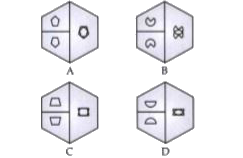In the list of animals given below, hen is the odd one out. (human being, cow, dog, hen)
The reason for this is
it undergoes internal fertilisation.
it is oviparous.
it is viviparous.
it undergoes external fertilisation.
The correct Answer is:B
To determine why the hen is the odd one out in the list of animals (human being, cow, dog, hen), we can analyze the reproductive methods of each animal.
1. Identify the Animals: The animals in the list are:
- Human being
- Cow
- Dog
- Hen
2. Understand Reproductive Methods:
- Human Being: Humans reproduce through internal fertilization and give birth to live young.
- Cow: Cows also reproduce through internal fertilization and give birth to live young.
- Dog: Dogs reproduce through internal fertilization and give birth to live young.
- Hen: Hens reproduce through external fertilization and are oviparous, meaning they lay eggs.
3. Compare the Reproductive Methods:
- The first three animals (human, cow, dog) are viviparous, meaning they give birth to live young after internal fertilization.
- The hen is oviparous, meaning it lays eggs after external fertilization.
4. Conclusion: The hen is the odd one out because it is the only animal in the list that lays eggs (oviparous), while the others give birth to live young (viviparous).
Final Answer:
The reason the hen is the odd one out is that it is oviparous (lays eggs), while human beings, cows, and dogs are viviparous (give birth to live young).
- Human being
- Cow
- Dog
- Hen
- Human Being: Humans reproduce through internal fertilization and give birth to live young.
- Cow: Cows also reproduce through internal fertilization and give birth to live young.
- Dog: Dogs reproduce through internal fertilization and give birth to live young.
- Hen: Hens reproduce through external fertilization and are oviparous, meaning they lay eggs.
- The first three animals (human, cow, dog) are viviparous, meaning they give birth to live young after internal fertilization.
- The hen is oviparous, meaning it lays eggs after external fertilization.
The reason the hen is the odd one out is that it is oviparous (lays eggs), while human beings, cows, and dogs are viviparous (give birth to live young).
Topper's Solved these Questions
- REPRODUCTION IN ANIMALSBOOK - NCERT EXEMPLARCHAPTER - REPRODUCTION IN ANIMALSEXERCISE - VERY SHORT ANSWER QUESTIONS
5 Videos
- REPRODUCTION IN ANIMALSBOOK - NCERT EXEMPLARCHAPTER - REPRODUCTION IN ANIMALSEXERCISE - SHORT ANSWER QUESTIONS
9 Videos
- REACHING THE AGE OF ADOLESCENCE BOOK - NCERT EXEMPLARCHAPTER - REACHING THE AGE OF ADOLESCENCE EXERCISE - LONG ANSWER QUESTIONS
11 Videos
- SYNTHETIC FIBRES AND PLASTICS BOOK - NCERT EXEMPLARCHAPTER - SYNTHETIC FIBRES AND PLASTICS EXERCISE - LONG ANSWER QUESTIONS
7 Videos
Similar Questions
Knowledge Check
Choose the odd one out of the given options
ASiliconBMagnesiumCTungstenDAurumChoose the odd one out of the given options
AMIFBRGCCDPRDEFQIn the list of organisms given below, those that reproduce by the asexual method are
(i) dog (ii) banana. (ii) yeast.(iv) amoeba.A(i) , (iii) and (iv)B(i),(ii) and (iii)C(i),(ii) and (iv)D(ii) and (iii) and (iv)
Find the odd one out of the following and give reason.
View SolutionFind the odd one out of the following and give reason.
View SolutionFind the odd one out of the following and give reason.
View SolutionFind the odd one out of the following and give reason.
View SolutionIn the list of organisms given below, those that reproduce by the asexual method are
(i) banana (ii) dog
(iii) yeast (iv) Amoeba
View Solution

